-
EngineTurbo 1.4L I4
-
Power138 HP / 148 LB-FT
-
Transmission6-Speed Manual
-
DrivetrainFront-Wheel Drive
-
Curb Weight3,011 LBS
-
Seating2+3
-
Cargo15.4 CU-FT
-
MPG28 City / 42 HWY
Is 42 MPG The Ultimate Answer To The Ultimate Question?
On paper, it sounds like an enthusiast's dream. Start by trimming almost 100 pounds from the curb weight of the base Chevrolet Cruze. Then drop the optional turbocharged engine underhood, bolted to a six-speed manual transmission. Lower the suspension and mount some lightweight, forged alloy wheels. Finish it off by sticking a little spoiler on the decklid, along with a special badge.
Where do we sign up?
But the car we've described isn't the stuff of boy racer fantasies; it's not even a performance car at all. No, the 2012 Chevrolet Cruze Eco is not meant to run circles around the competition on an autocross course as much as it is designed to pirouette its way around the Environmental Protection Agency's fuel economy test. It's the greenest machine to wear a Bowtie this side of the Volt, boasting a highway fuel economy of 42 miles per gallon. But that heady figure is accomplished without the benefit of any advanced hybrid powertrain technology. The Cruze Eco is an impressive package that proves GM's smarts and gives the company further green bragging rights. That said, we're not entirely sure it's the Cruze we'd park in our driveway.
General Motors rolled out the Eco for the 2011 model year, building on the fuel-sipper program it pioneered with the 37-mpg Chevrolet Cobalt SFE. But with the Cruze, GM engineers went to greater lengths to improve fuel economy, and they've made some further changes for 2012.
We'll get into an analysis of the tricks that makes the Cruze Eco special, but first let's emphasize what GM didn't do to punch up the Eco's mileage. This is a car without any hybrid technology, not even a mild hybrid system like the eAssist system GM deployed on the Buick LaCrosse and has planned for the 2013 Chevrolet Malibu Eco. There's no start-stop system to aid Cruze Eco's 28 miles per gallon city fuel economy rating. In fact, the Cruze Eco's turbocharged 1.4-liter four-cylinder doesn't even use direct injection to make its 138 horsepower and 148 lb-ft of torque.
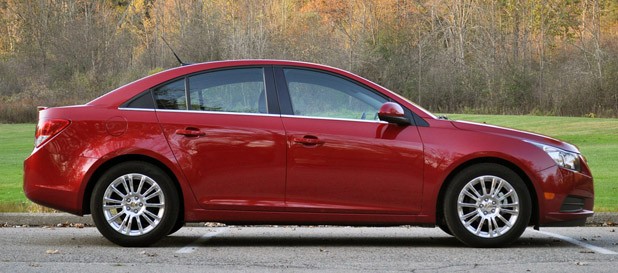
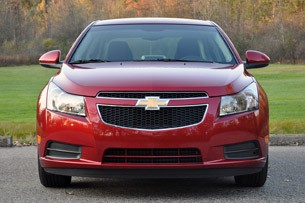
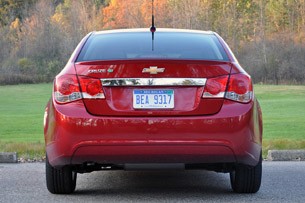
So what did GM really do? Three smart things. First, those clever engineers put the Cruze on a good old fashioned diet. They trimmed an easy 21 pounds by virtue of an attractive set of polished alloy wheels and another 26 by replacing the spare tire and jack with a 12-volt electric tire pump. The fuel tank was shrunk by three gallons and the rear suspension design was simplified, eliminating even more weight. The icing on the cake is that GM says it was able to reduce the sheet metal gauge thickness in some areas of the body-in-white, while reducing the length of some of the weld flanges to pare even more mass. This last change has now been deployed throughout the Cruze lineup, with the lighter body structure being adopted as a running change during the first model year.
The second key to the Eco's thrifty nature are some aerodynamic improvements that start with lowering the vehicle by 10mm. Even more importantly, the Cruze Eco gets some special kit, like underbody panels and an "active" front fascia, which can close up airflow passages to cut drag. (This means you can't tow with a Cruze Eco, which isn't a big deal.) Low rolling resistance tires also find a home on the Eco, which GM says has a 0.298 coefficient of drag – not far off the 0.287 of the Volt.
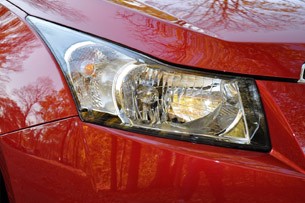
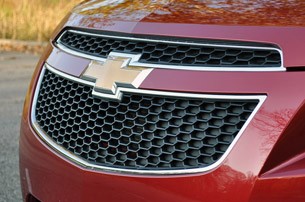
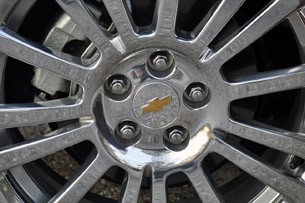
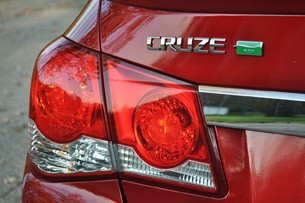
Finally, we come to the most important of the Eco's singularities: A six-speed manual transmission with not one, not two, but three overdrive gears. Here is where things begin to get complicated, because you can also get a Cruze Eco with the same six-speed automatic used in other Cruze trims. It doesn't perform as well on the EPA cycle, achieving a still-commendable 26/39 rating and leading GM to retain the normal-sized fuel tank. This contributes to a curb weight of 3,102 pounds; 91 pounds heavier than the Eco manual. Fuel economy in the automatic is actually an improvement over the 2011 model's 26/37, a change attributable to a taller final drive in the 2012 model year automatic. Said gearing revision has been applied to automatics across the board for 2012, on all trim levels, which is significant.
Before we go further, and in the interest of clarity, understand that the Cruze is offered in three distinct trim levels besides Eco. The base car, powered by a naturally aspirated 1.8-liter four, is designated "LS." In the middle, there are two "LT" models, and at the top-of-the-line is the "LTZ." In two model years, GM has offered nine different powertrain combinations on the Cruze, including four different transmissions – you'll need a scorecard to keep up.
Parsing all the possible powertrain combinations on the Cruze is necessary because, as attractive as that 42 mpg number is, most people like automatics. That GM has to deploy a manual to hit that number is something of a problem, given that the Ford Focus and Hyundai Elantra nail 40 EPA-rated miles per gallon with automatics. (Ford has its own problem on this score: A less-than-smooth-shifting dual-clutch gearbox.) Even if you prefer rowing your own gears, the Eco's manual transmission can be frustrating. The special tranny has a "normal" first gear (the same as the manual in the LS and LT), so its initial acceleration is quite good, brisk even, as the little four-cylinder's turbo spools up. Second is useable too. But with further gear changes at normal shift points, the engine keeps dropping out of its sweet spot on the power curve. If we had a dollar for every time we found ourselves lugging the engine, waiting for the turbo to catch up to our right foot, we would have had enough cash on hand after a week to have sprung for the automatic – which might just be a better option anyway.
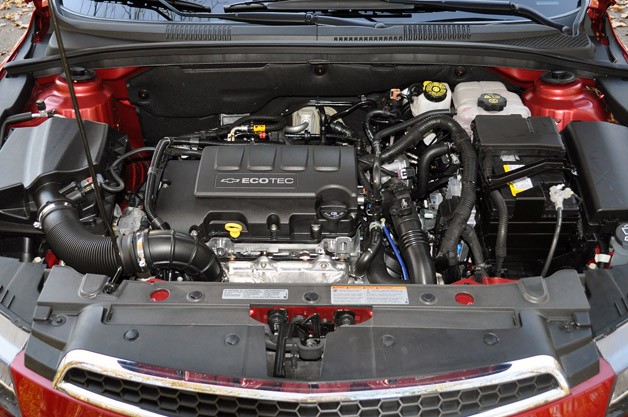
Rather, we found ourselves shifting differently than we would most manual gearboxes, almost entirely avoiding the use of fourth and fifth, the first two of the three power-sapping overdrive gears. Sixth sure was nice for cruising on the freeway, however, as we saw our best 50-mile average fuel economy, as displayed on the Cruze Eco's trip computer, of 48 miles per gallon. Overall observed fuel economy during our week-long test drive was 34 mpg, beating the EPA combined estimate by a single mile per gallon. Is that enough to live with the maximum overdrive transmission? That's the ultimate question – can life, the universe, and everything be boiled down to fuel economy?
As much as we missed having a properly geared manual transmission in the Eco, we didn't find the elimination of the standard Z-link rear suspension to be any problem whatsoever. Now, this might have something to do with the way we drove the Eco, which, rolling on its special tires, didn't exactly invite us to thrash it. While the standard Cruze is a decent handling car with competent steering and a comfortable ride, so too is the Eco, which feels even lighter on its feet. Nobody is going to confuse any Cruze with a BMW, but there is nothing wrong with its driving dynamics, especially considering the intended market. Sure, the Cruze's electric power steering could offer more feedback and it can certainly feel overboosted at low speeds, but in its defense, it has a linear progression and is markedly improved compared to GM's earlier efforts with the technology.
The Cruze Eco starts at an entirely reasonable $19,245, plus a $750 destination charge, placing it right in between the two different LT trims Chevy offers. While that's an $820 price hike from 2011, the previously optional $525 Connectivity Plus Cruise package is now standard.
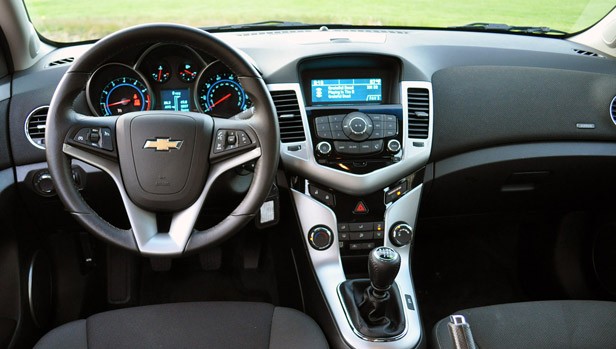
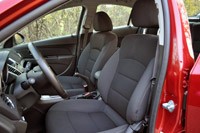
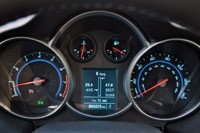
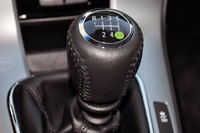
In assessing how we ultimately feel about the Eco, let's start by saying we think the Cruze is a good car, in aggregate. Everything we've said about the standard Cruze holds true here: The Eco is a nice looking car with a quiet and comfortable cockpit, right down to its fabric-covered burlesque dashboard. But it's a one-trick-pony. While we like the idea of the 42-mpg Eco and we love its fuel economy, we're pretty sure its biggest competition lies with the rest of the Cruze lineup. There is a growing range of fuel efficient, 40-mpg cars selling at the same price-point, from the Honda Insight hybrid to the aforementioned Focus and Elantra. While the Eco compares well with all of them – heck, it does boast the highest highway mileage number of any vehicle powered exclusively by a conventional internal combustion engine – the mileage improvements to the other Cruze trims make the Eco less compelling on its own.
The automatic Cruze LT and LTZ models for 2012 saw a bump in fuel economy, and now come close to the automatic Eco at 26/38, giving up just a single mile per gallon on the highway. Also worth noting is that LT Cruzes are now being offered with a standard manual transmission (meaning the automatic is now $995 extra). This is the very same gearbox as in the base model, without the overdrive gearing of the Eco. In this application it gives the Cruze a fuel economy rating of 26/38 – equivalent to the automatic and, again, only a mile per gallon behind the Eco automatic.
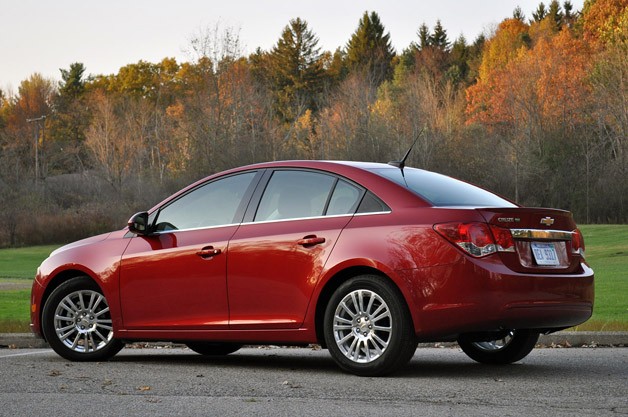
While we entirely understand the marketing impetus of having a separate "green" trim level, we wish GM would just allow for ordering the Eco with the LT's manual trans. The conventionally geared tranny might give up a couple of miles per gallon, but it sure would be easier to live with. Having the option of leather seats would be nice too. While we're sure the leather interior weighs a bit more than cloth and isn't as in line with tree-hugger sensibilities, it seems more fitting to the Eco's mission statement than offering a remote starter, which GM does. Or it could just let the LT manual be had with the Eco's alloys and aero package, and be done with it.
If this sounds like we're making a case for just incorporating the Eco's weight-saving and aerodynamic qualities into the other trim levels, well, that's pretty close to it. That GM has already confirmed a diesel Cruze for next year, which will no doubt best the Eco in thriftiness, only reinforces our position. Certainly for some a three or four mile per gallon boost in the manual Eco is worth its trade-offs. But if GM wants to make a more compelling case – the forthcoming diesel engine notwithstanding – it should punch up that mileage differential by throwing eAssist and direct injection at the Cruze Eco. Now there's some substantial technology that could give this trim level an identity more its own.
On paper, it sounds like an enthusiast's dream. Start by trimming almost 100 pounds from the curb weight of the base Chevrolet Cruze. Then drop the optional turbocharged engine underhood, bolted to a six-speed manual transmission. Lower the suspension and mount some lightweight, forged alloy wheels. Finish it off by sticking a little spoiler on the decklid, along with a special badge.
Where do we sign up?
But the car we've described isn't the stuff of boy racer fantasies; it's not even a performance car at all. No, the 2012 Chevrolet Cruze Eco is not meant to run circles around the competition on an autocross course as much as it is designed to pirouette its way around the Environmental Protection Agency's fuel economy test. It's the greenest machine to wear a Bowtie this side of the Volt, boasting a highway fuel economy of 42 miles per gallon. But that heady figure is accomplished without the benefit of any advanced hybrid powertrain technology. The Cruze Eco is an impressive package that proves GM's smarts and gives the company further green bragging rights. That said, we're not entirely sure it's the Cruze we'd park in our driveway.
General Motors rolled out the Eco for the 2011 model year, building on the fuel-sipper program it pioneered with the 37-mpg Chevrolet Cobalt SFE. But with the Cruze, GM engineers went to greater lengths to improve fuel economy, and they've made some further changes for 2012.
We'll get into an analysis of the tricks that makes the Cruze Eco special, but first let's emphasize what GM didn't do to punch up the Eco's mileage. This is a car without any hybrid technology, not even a mild hybrid system like the eAssist system GM deployed on the Buick LaCrosse and has planned for the 2013 Chevrolet Malibu Eco. There's no start-stop system to aid Cruze Eco's 28 miles per gallon city fuel economy rating. In fact, the Cruze Eco's turbocharged 1.4-liter four-cylinder doesn't even use direct injection to make its 138 horsepower and 148 lb-ft of torque.



So what did GM really do? Three smart things. First, those clever engineers put the Cruze on a good old fashioned diet. They trimmed an easy 21 pounds by virtue of an attractive set of polished alloy wheels and another 26 by replacing the spare tire and jack with a 12-volt electric tire pump. The fuel tank was shrunk by three gallons and the rear suspension design was simplified, eliminating even more weight. The icing on the cake is that GM says it was able to reduce the sheet metal gauge thickness in some areas of the body-in-white, while reducing the length of some of the weld flanges to pare even more mass. This last change has now been deployed throughout the Cruze lineup, with the lighter body structure being adopted as a running change during the first model year.
The second key to the Eco's thrifty nature are some aerodynamic improvements that start with lowering the vehicle by 10mm. Even more importantly, the Cruze Eco gets some special kit, like underbody panels and an "active" front fascia, which can close up airflow passages to cut drag. (This means you can't tow with a Cruze Eco, which isn't a big deal.) Low rolling resistance tires also find a home on the Eco, which GM says has a 0.298 coefficient of drag – not far off the 0.287 of the Volt.




Finally, we come to the most important of the Eco's singularities: A six-speed manual transmission with not one, not two, but three overdrive gears. Here is where things begin to get complicated, because you can also get a Cruze Eco with the same six-speed automatic used in other Cruze trims. It doesn't perform as well on the EPA cycle, achieving a still-commendable 26/39 rating and leading GM to retain the normal-sized fuel tank. This contributes to a curb weight of 3,102 pounds; 91 pounds heavier than the Eco manual. Fuel economy in the automatic is actually an improvement over the 2011 model's 26/37, a change attributable to a taller final drive in the 2012 model year automatic. Said gearing revision has been applied to automatics across the board for 2012, on all trim levels, which is significant.
Before we go further, and in the interest of clarity, understand that the Cruze is offered in three distinct trim levels besides Eco. The base car, powered by a naturally aspirated 1.8-liter four, is designated "LS." In the middle, there are two "LT" models, and at the top-of-the-line is the "LTZ." In two model years, GM has offered nine different powertrain combinations on the Cruze, including four different transmissions – you'll need a scorecard to keep up.
Parsing all the possible powertrain combinations on the Cruze is necessary because, as attractive as that 42 mpg number is, most people like automatics. That GM has to deploy a manual to hit that number is something of a problem, given that the Ford Focus and Hyundai Elantra nail 40 EPA-rated miles per gallon with automatics. (Ford has its own problem on this score: A less-than-smooth-shifting dual-clutch gearbox.) Even if you prefer rowing your own gears, the Eco's manual transmission can be frustrating. The special tranny has a "normal" first gear (the same as the manual in the LS and LT), so its initial acceleration is quite good, brisk even, as the little four-cylinder's turbo spools up. Second is useable too. But with further gear changes at normal shift points, the engine keeps dropping out of its sweet spot on the power curve. If we had a dollar for every time we found ourselves lugging the engine, waiting for the turbo to catch up to our right foot, we would have had enough cash on hand after a week to have sprung for the automatic – which might just be a better option anyway.

Rather, we found ourselves shifting differently than we would most manual gearboxes, almost entirely avoiding the use of fourth and fifth, the first two of the three power-sapping overdrive gears. Sixth sure was nice for cruising on the freeway, however, as we saw our best 50-mile average fuel economy, as displayed on the Cruze Eco's trip computer, of 48 miles per gallon. Overall observed fuel economy during our week-long test drive was 34 mpg, beating the EPA combined estimate by a single mile per gallon. Is that enough to live with the maximum overdrive transmission? That's the ultimate question – can life, the universe, and everything be boiled down to fuel economy?
As much as we missed having a properly geared manual transmission in the Eco, we didn't find the elimination of the standard Z-link rear suspension to be any problem whatsoever. Now, this might have something to do with the way we drove the Eco, which, rolling on its special tires, didn't exactly invite us to thrash it. While the standard Cruze is a decent handling car with competent steering and a comfortable ride, so too is the Eco, which feels even lighter on its feet. Nobody is going to confuse any Cruze with a BMW, but there is nothing wrong with its driving dynamics, especially considering the intended market. Sure, the Cruze's electric power steering could offer more feedback and it can certainly feel overboosted at low speeds, but in its defense, it has a linear progression and is markedly improved compared to GM's earlier efforts with the technology.
The Cruze Eco starts at an entirely reasonable $19,245, plus a $750 destination charge, placing it right in between the two different LT trims Chevy offers. While that's an $820 price hike from 2011, the previously optional $525 Connectivity Plus Cruise package is now standard.




In assessing how we ultimately feel about the Eco, let's start by saying we think the Cruze is a good car, in aggregate. Everything we've said about the standard Cruze holds true here: The Eco is a nice looking car with a quiet and comfortable cockpit, right down to its fabric-covered burlesque dashboard. But it's a one-trick-pony. While we like the idea of the 42-mpg Eco and we love its fuel economy, we're pretty sure its biggest competition lies with the rest of the Cruze lineup. There is a growing range of fuel efficient, 40-mpg cars selling at the same price-point, from the Honda Insight hybrid to the aforementioned Focus and Elantra. While the Eco compares well with all of them – heck, it does boast the highest highway mileage number of any vehicle powered exclusively by a conventional internal combustion engine – the mileage improvements to the other Cruze trims make the Eco less compelling on its own.
The automatic Cruze LT and LTZ models for 2012 saw a bump in fuel economy, and now come close to the automatic Eco at 26/38, giving up just a single mile per gallon on the highway. Also worth noting is that LT Cruzes are now being offered with a standard manual transmission (meaning the automatic is now $995 extra). This is the very same gearbox as in the base model, without the overdrive gearing of the Eco. In this application it gives the Cruze a fuel economy rating of 26/38 – equivalent to the automatic and, again, only a mile per gallon behind the Eco automatic.

While we entirely understand the marketing impetus of having a separate "green" trim level, we wish GM would just allow for ordering the Eco with the LT's manual trans. The conventionally geared tranny might give up a couple of miles per gallon, but it sure would be easier to live with. Having the option of leather seats would be nice too. While we're sure the leather interior weighs a bit more than cloth and isn't as in line with tree-hugger sensibilities, it seems more fitting to the Eco's mission statement than offering a remote starter, which GM does. Or it could just let the LT manual be had with the Eco's alloys and aero package, and be done with it.
If this sounds like we're making a case for just incorporating the Eco's weight-saving and aerodynamic qualities into the other trim levels, well, that's pretty close to it. That GM has already confirmed a diesel Cruze for next year, which will no doubt best the Eco in thriftiness, only reinforces our position. Certainly for some a three or four mile per gallon boost in the manual Eco is worth its trade-offs. But if GM wants to make a more compelling case – the forthcoming diesel engine notwithstanding – it should punch up that mileage differential by throwing eAssist and direct injection at the Cruze Eco. Now there's some substantial technology that could give this trim level an identity more its own.










Sign in to post
Please sign in to leave a comment.
Continue